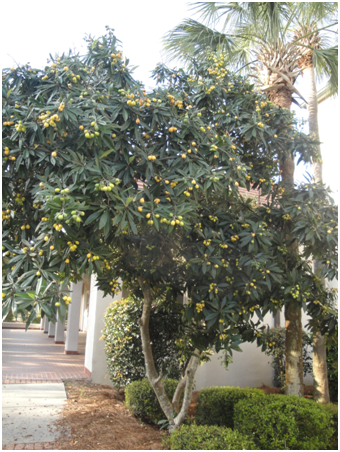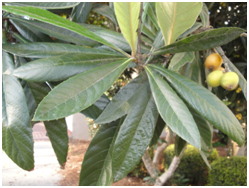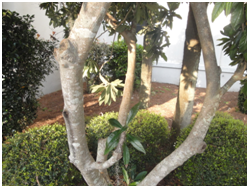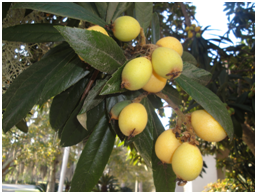Loquat
Eriobotrya japonica

(Photo by Asia Comer)
View the Location on Campus
Taxonomy (1)
Classification: Angiosperm, dicot
Family: Rosaceae
Common name: Japanese plum, Loquat
General Information (1,3,4)
Region of Origin: China and Japan
USDA Plants Hardiness Zones: 7-10
Growth Habit: Tree
- Size: 20-30 feet
- Deciduous/Evergreen: Evergreen
- Flowering: Late Fall
- Fruiting: Spring-Summer
Diagnostic Characteristics
Leaves (2)
- Arrangement: Alternate
- Simple/Compound: Simple
- Other: 6-9 inches long, toothed, wrinkled, tomentose underside

(Photo by Asia Comer)
Stem/Bark (2)
- Color: Grayish
- Texture: Pubescent

(Photo by Asia Comer)
Flower (2)
- Perfect/Imperfect: Perfect
- Color: White
- Size: 0.5-0.75 inch
- Inflorescence type: Terminal panicle
Fruit (2)
- Fruit type: Pome
- Size: 1-1.75 inch
- Color: Yellow

(Photo by Asia Comer)
Horticultural Information (1,3,4)
- Light: Full sun
- Moisture: Adequate
- Maintenance: Easy to care for
- Landscape Uses: Ornamental, shade tree
- Other: Avoid cold temperatures
Interesting Facts (1)
- Loquat fruit is a tasty treat that can be enjoyed fresh, dried or in jams and preserves
References
1) Crane, J. (2012). Loquat growing in the florida home landscape. Manuscript submitted for publication, Institute of Food and Agricultural Sciences , University of Florida, Retrieved from http://edis.ifas.ufl.edu/mg050
2) Dirr, M. (1998). Manual of Woody Landscape Plants. (5th ed., pp. 208-211). Champaign, Illinois: Stipes Publishing L.L.C.
3) Scheper, J. (n.d.). Eriobotrya japonica. Retrieved from http://www.floridata.com/ref/E/eriobot.cfm
4) United States Department of Agriculture, Natural Resources Conservation Service. Eriobotrya japonica (Thunb.) Lindl. Loquat. Retrieved from website: http://plants.usda.gov/java/profile?symbol=erja3
Edited by Jessica Bartek
Department of Biology
-
Room 2035, 2nd Floor
Bailey Science Building -
Mailing Address
1500 N. Patterson St.
Valdosta, GA 31698 - Phone: 229.333.5759
- Fax: 229.245.6585
Monday - Thursday
8:00AM until 5:30PM
Friday
8:00AM until 3:00PM
Saturday - Sunday
Office Closed